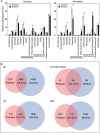Patterns and Processes in Marine Microeukaryotic Community Biogeography from Xiamen Coastal Waters and Intertidal Sediments, Southeast China
- PMID: 29075237
- PMCID: PMC5644358
- DOI: 10.3389/fmicb.2017.01912
Patterns and Processes in Marine Microeukaryotic Community Biogeography from Xiamen Coastal Waters and Intertidal Sediments, Southeast China
Abstract
Microeukaryotes play key roles in the structure and functioning of marine ecosystems. Little is known about the relative importance of the processes that drive planktonic and benthic microeukaryotic biogeography in subtropical offshore areas. This study compares the microeukaryotic community compositions (MCCs) from offshore waters (n = 12) and intertidal sediments (n = 12) around Xiamen Island, southern China, using high-throughput sequencing of 18S rDNA. This work further quantifies the relative contributions of spatial and environmental variables on the distribution of marine MCCs (including total, dominant, rare and conditionally rare taxa). Our results showed that planktonic and benthic MCCs were significantly different, and the benthic richness (6627 OTUs) was much higher than that for plankton (4044 OTUs) with the same sequencing effort. Further, we found that benthic MCCs exhibited a significant distance-decay relationship, whereas the planktonic communities did not. After removing two unique sites (N2 and N3), however, 72% variation in planktonic community was explained well by stochastic processes. More importantly, both the environmental and spatial factors played significant roles in influencing the biogeography of total and dominant planktonic and benthic microeukaryotic communities, although their relative effects on these community variations were different. However, a high proportion of unexplained variation in the rare taxa (78.1-97.4%) and conditionally rare taxa (49.0-81.0%) indicated that more complex mechanisms may influence the assembly of the rare subcommunity. These results demonstrate that patterns and processes in marine microeukaryotic community assembly differ among the different habitats (coastal water vs. intertidal sediment) and different communities (total, dominant, rare and conditionally rare microeukaryotes), and provide novel insight on the microeukaryotic biogeography and ecological mechanisms in coastal waters and intertidal sediments at local scale.
Keywords: benthos; biogeography; community assembly; deterministic processes; neutral model; plankton; stochastic processes; variation partitioning analysis.
Figures




Similar articles
-
Stochastic processes shape microeukaryotic community assembly in a subtropical river across wet and dry seasons.Microbiome. 2019 Oct 22;7(1):138. doi: 10.1186/s40168-019-0749-8. Microbiome. 2019. PMID: 31640783 Free PMC article.
-
Integrated Biogeography and Assembly Mechanisms of Microeukaryotic Communities in Coastal Waters Near Shellfish Cultivation.Microb Ecol. 2023 Nov;86(4):2560-2573. doi: 10.1007/s00248-023-02256-0. Epub 2023 Jul 6. Microb Ecol. 2023. PMID: 37415043
-
Microeukaryotic biogeography in the typical subtropical coastal waters with multiple environmental gradients.Sci Total Environ. 2018 Sep 1;635:618-628. doi: 10.1016/j.scitotenv.2018.04.142. Epub 2018 Apr 24. Sci Total Environ. 2018. PMID: 29679834
-
Long-term oceanographic and ecological research in the Western English Channel.Adv Mar Biol. 2005;47:1-105. doi: 10.1016/S0065-2881(04)47001-1. Adv Mar Biol. 2005. PMID: 15596166 Review.
-
Progress in studies on the diversity and distribution of planktonic ciliates (Protista, Ciliophora) in the South China Sea.Mar Life Sci Technol. 2020 Nov 6;3(1):28-43. doi: 10.1007/s42995-020-00070-y. eCollection 2021 Feb. Mar Life Sci Technol. 2020. PMID: 37073391 Free PMC article. Review.
Cited by
-
Invasion by Cordgrass Increases Microbial Diversity and Alters Community Composition in a Mangrove Nature Reserve.Front Microbiol. 2017 Dec 15;8:2503. doi: 10.3389/fmicb.2017.02503. eCollection 2017. Front Microbiol. 2017. PMID: 29326666 Free PMC article.
-
Distinct responses of airborne abundant and rare microbial communities to atmospheric changes associated with Chinese New Year.Imeta. 2023 Oct 11;2(4):e140. doi: 10.1002/imt2.140. eCollection 2023 Nov. Imeta. 2023. PMID: 38868217 Free PMC article.
-
A Tripartite Microbial-Environment Network Indicates How Crucial Microbes Influence the Microbial Community Ecology.Microb Ecol. 2020 Feb;79(2):342-356. doi: 10.1007/s00248-019-01421-8. Epub 2019 Aug 19. Microb Ecol. 2020. PMID: 31428833
-
Sargasso Sea bacterioplankton community structure and drivers of variance as revealed by DNA metabarcoding analysis.PeerJ. 2022 Feb 28;10:e12835. doi: 10.7717/peerj.12835. eCollection 2022. PeerJ. 2022. PMID: 35251777 Free PMC article.
-
Geographic Patterns of Bacterioplankton among Lakes of the Middle and Lower Reaches of the Yangtze River Basin, China.Appl Environ Microbiol. 2020 Mar 2;86(6):e02423-19. doi: 10.1128/AEM.02423-19. Print 2020 Mar 2. Appl Environ Microbiol. 2020. PMID: 31924617 Free PMC article.
References
-
- Barberán A., Casamayor E. O. (2010). Global phylogenetic community structure and β-diversity patterns in surface bacterioplankton metacommunities. Aquat. Microb. Ecol. 59 1–10. 10.3354/ame01389 - DOI
-
- Borcard D., Legendre P. (2002). All-scale spatial analysis of ecological data by means of principal coordinates of neighbour matrices. Ecol. Model. 153 51–68. 10.1016/S0304-3800(01)00501-4 - DOI
LinkOut - more resources
Full Text Sources
Other Literature Sources

